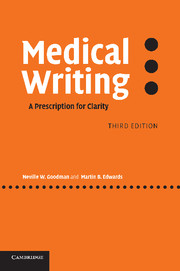Appendix: examples to rewrite
Published online by Cambridge University Press: 23 November 2009
Summary
Example 1
In the case of this particular elderly patient hypertensive population, reduction of blood pressure by 18/11 mmHg was achieved for a mean duration of follow up period of 4.4 years. However, with regard to overall mortality, there was no effect nor was there any effect on the incidence of occurrence of myocardial infarction, whether of fatal or non-fatal nature. With respect to cardiovascular accidents, a reduction in incidence of 42% was encountered, and this was mainly associated with strokes leading to fatality or serious neurological sequelae. Although it was not significant, cardiovascular mortality was shown to be reduced by 22%.
Example 2
There were 41 hospitalizations, with similar numbers in the three day and five day treatments (18 and 23, respectively).
Example 3
The superiority of 18-gauge catheters has not previously been demonstrated.
Example 4
The new scan typically detects more fractures, plain films detect more malalignments; the two modalities performing in a complimentary fashion.
Example 5
Until recently, no scientific methodology has been available to assess symptoms or objective degree of genitourinary prolapse; without such methodology the design of clinical trials has been problematic.
Example 6
These trials have led to the evidence-based introduction of several new drugs, some of which have been shown to impact on overall survival.
Example 7
The time-consuming aspects of data collection were minimised by the number of auditors and inconsistencies in coding minimised by the presence of a consultant.
- Type
- Chapter
- Information
- Medical WritingA Prescription for Clarity, pp. 231 - 238Publisher: Cambridge University PressPrint publication year: 2006



